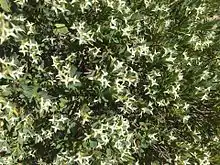| Daphne oleoides | |
|---|---|
 | |
| Growing in Tannourine cedar reserve, Lebanon | |
| Scientific classification | |
| Kingdom: | Plantae |
| Clade: | Tracheophytes |
| Clade: | Angiosperms |
| Clade: | Eudicots |
| Clade: | Rosids |
| Order: | Malvales |
| Family: | Thymelaeaceae |
| Genus: | Daphne |
| Species: | D. oleoides |
| Binomial name | |
| Daphne oleoides Schreb.[1] | |
Daphne oleoides is a shrub of the family Thymelaeaceae. It is native to the southern Europe, northern Africa, and Asia Minor.[1]
Description
The shrub is evergreen, and grows up to 60 cm tall. Its branches grow upright. Its flowers are white, with a purplish outside and it bears orange fruits. It is often found on calcareous rocks and rocky slopes at altitudes of 1700 to 2300 m.[1][2]
Subtaxa
- Daphne oleoides subsp. baksanica
- Daphne oleoides subsp. kurdica (syn. Daphne kurdica)
- Daphne oleoides subsp. transcaucasica
- Daphne oleoides var. brachyloba
- Daphne oleoides var. buxifolia
- Daphne oleoides var. glandulosa
References
- 1 2 3 "Daphne oleoides". Daphne-Seidelbast. Retrieved 25 May 2016.
- ↑ "Daphne oleoides-Schreb". Plants for a Future. Retrieved 25 May 2016.
This article is issued from Wikipedia. The text is licensed under Creative Commons - Attribution - Sharealike. Additional terms may apply for the media files.